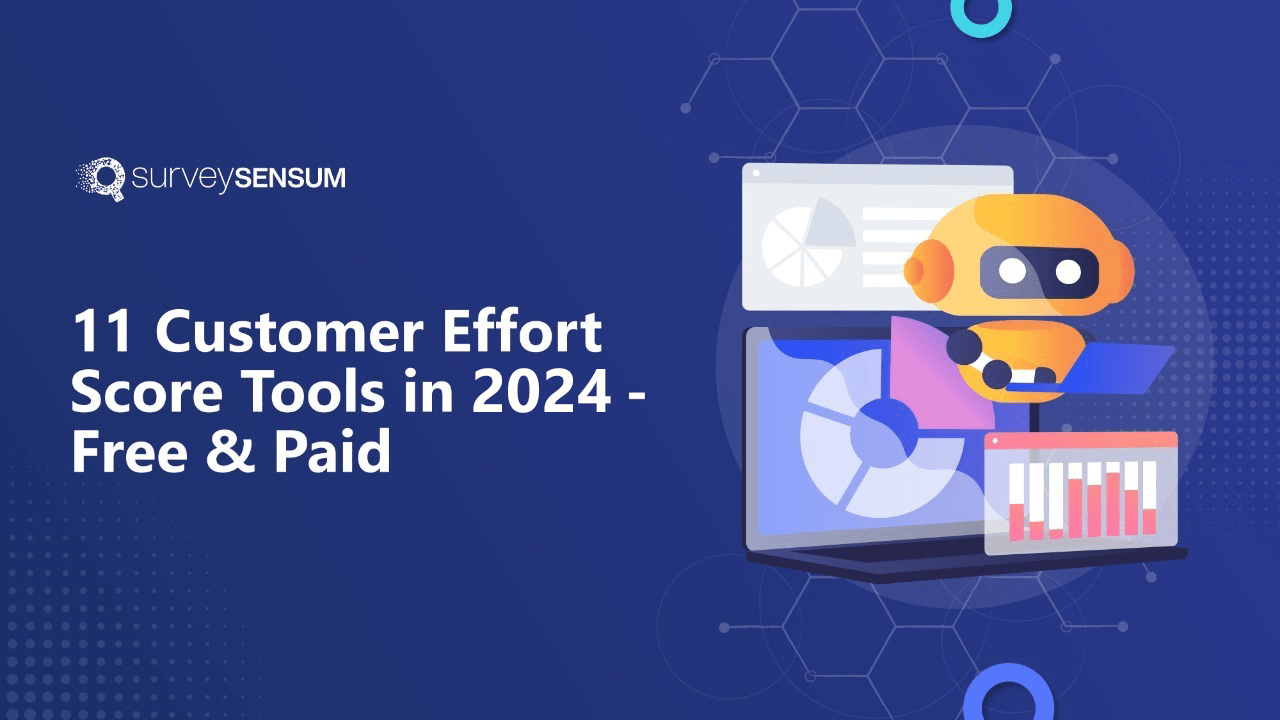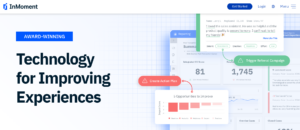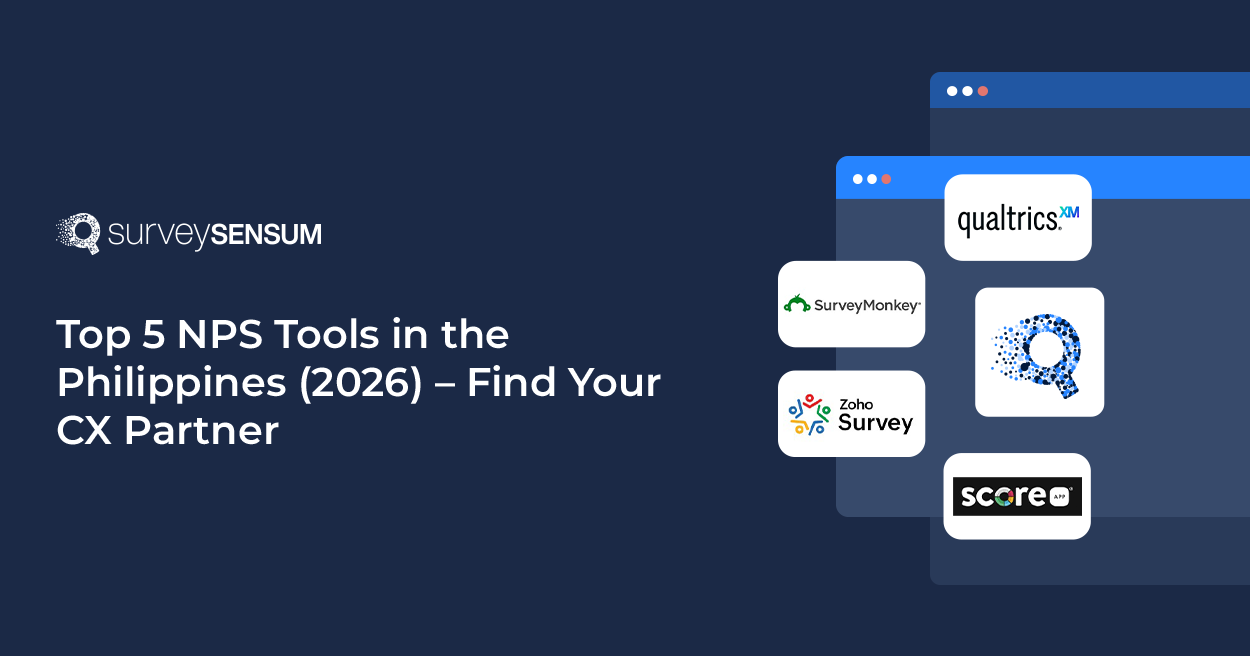

Every business wants to build a loyal customer base to run its business in the long run.
But, how do you build a loyal customer base? Is it all about the quality of your products and services alone? Or is there something else involved in creating loyal customers?
For instance, earlier we weighed customer loyalty only on the quality of products and services sold. But, it then became evident that customer loyalty also resembles the effort your customers put in to acquire your products and services.
If your customers can’t find immediate solutions to their queries, connect to a customer support section to raise an issue, and get reliable customer assistance, they become disloyal. And, that means the more extra effort they need to put in to interact with your business, the more disloyal they become.
To resolve all these issues and help businesses measure and improve their Customer Effort Score (CES), several companies have developed CES tools like SurveySensum, Qualtrics, SurveyMonkey, etc.
Therefore, in this article, we will discuss points like what is a CES score, how to measure it, and what are the top 11 CES tools in 2024, etc. in detail.
Explaining CES Tools and CES Score
Features of a Good CES Survey Tool
Detailed Comparison of Top 6 CES Tools
#1 SurveySensum
#2 Qualtrics
#3 Nicereply
#4 SurveyMonkey
#5 SurveySparrow
#6 InMoment
#7 Jotform
#8 Typeform
#9 Retently
#10 Qualaroo
#11 – QuestionPro
Explaining CES Tools and CES Score
Now, let us examine what a good CES score is, how to calculate it, and how a CES tool helps you.
The idea behind measuring the customer effort score came from the Harvard Business Review. It explained the importance of delighting the customer and measuring the CES score to understand their ease of using your services and satisfaction.
So, what is a good CES score and how do you calculate it?
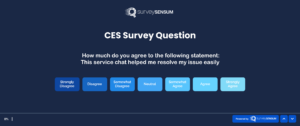
CES is a metric that tells you how easy it was for your customers to do business with you. A business can launch CES surveys to calculate the CES score on a scale of 1-7 and identify how effortful it was for a customer to resolve an issue, raise a ticket, get assistance, or purchase a product or service. A score of 1 indicates ‘very high effort’, whereas a score of 7 indicates ‘very low effort’.
A good CES score
A good CES score would be anything above 5. If you have lower scores, it is time to identify the friction and resolve issues immediately to improve their experience.
But, when to launch a CES survey?
You can launch the CES surveys immediately after a purchase or an interaction with the customer, or you can use them to examine the overall customer experience.
And, how to calculate CES score?
You need to calculate the average score of the CES survey responses to understand the CES score. The formula to calculate the CES score would be as follows;
CES score = (Total sum of responses) / (Number of responses)
What is a CES tool, and how does it work?
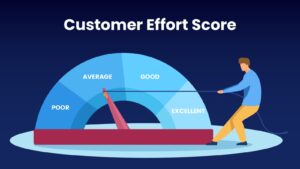
A Customer Effort Score tool is software designed to help businesses create and launch interactive CES surveys instantly without any hassles. It lets you brand your surveys with logos, texts, and other elements. It also comes with in-built survey templates and different types of customer effort score questions. A good CES tool can also let you send follow-up questions, create real-time reports and summaries, and share the surveys over multiple channels and sources.
A CES tool has the ability to add follow-up questions, integrate them with your helpdesks, generate real-time reports, collaborate with your team members, and work in sync with other customer experience tools.
Features of a Good CES Survey Tool
Before we dive into the top CES tools, let’s take a look at some key features that make a CES survey tool good.
- The tool should provide the ability to add follow-up questions according to the survey score.
- It should offer real-time CES reports.
- It should allow the integration of help desk tools.
- And it should also be able to gauge other CX metrics. In other words, the tool should have the ability to conduct not just CES, but also NPS and CSAT surveys.
Let’s move on to the top CES tools for your business.
Detailed Comparison of Top 6 CES Tools
| SurveySensum | Qualtrics | NiceReply | SurveyMonkey | SurveySparrow | InMoment | |
| Built-In Templates | ✅ | ✅ | ✅ | ✅ | ✅ | ✅ |
| Advance Survey Logic | ✅ | ✅ | ✅ | ✅ | ✅ | ✅ |
| CX Consultation | ✅ | ❌ | ❌ | ✅ | ❌ | ❌ |
| Implementation Support | ✅ | ❌ | ❌ | ✅ | ❌ | ❌ |
| New Features Requests | ✅ | ✅ | ❌ | ❌ | ✅ | ❌ |
| Free Version | ✅ | ✅ | ❌ | ✅ | ✅ | ❌ |
| Free Trial | ✅ | ✅ | ✅ | ✅ | ✅ | ✅ |
| Question Types | ✅ | ✅ | ✅ | ✅ | ✅ | ✅ |
| Customization of Survey | ✅ | ✅ | ✅ | ✅ | ✅ | ✅ |
| White Label | ✅ | ✅ | ✅ | ✅ | ✅ | ✅ |
| Survey Trigger (Open APIs) | ✅ | ✅ | ✅ | ✅ | ✅ | ✅ |
| Role Based Access | ✅ | ✅ | ✅ | ✅ | ✅ | ✅ |
| Omnichannel Survey | ✅ | ✅ | ✅ | ✅ | ✅ | ✅ |
| Automated Dashboards | ✅ | ✅ | ✅ | ✅ | ✅ | ✅ |
| Customization of Dashboards | ✅ | ✅ | ✅ | ✅ | ✅ | ✅ |
| Role Based Dashboards | ✅ | ✅ | ✅ | ✅ | ✅ | ✅ |
| Text Analysis | ✅ | ✅ | ✅ | ✅ | ✅ | ✅ |
| Close Loop Ticketing System | ✅ | ✅ | ✅ | ✅ | ✅ | ✅ |
| Role Based Access | ✅ | ✅ | ✅ | ✅ | ✅ | ✅ |
| Historical Data Analysis | ✅ | ✅ | ✅ | ✅ | ✅ | ✅ |
| Pricing | Affordable | Expensive | Affordable | Affordable | Affordable | Contact the team |
| Customer Support Channels | 24*7 Live Chat Support, Call Support, Email Support, and Social Media Support | Live Chat Support, Call Support, Email Support, and Social Media Support | Chat Support, and Email Support | Chat Support, and Email Support | Chat Support, Email, Support, and Knowledge Base | Chat Support, and Email Support |
| G2 Review Score | 4.7 | 4.4 | 4.5 | 4.4 | 4.4 | 4.7 |
Top 11 CES tools in 2024
Here’s a compiled list of the top 11 Customer Effort Score tools in 2024 to help you create and launch CES surveys hassle-free and improve your customer’s experience.
#1 SurveySensum
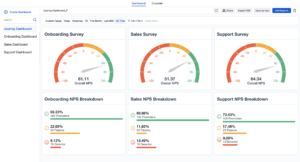 SurveySensum is the most efficient CES tool in 2024 compared to its counterparts in terms of pricing, usability, analytics, and results. It uses advanced tools, text analysis, insightful dashboards, word clouds, and more to help you identify disappointed customers, brand your surveys, eliminate duplication, improve analytics, and create quicker and faster surveys.
SurveySensum is the most efficient CES tool in 2024 compared to its counterparts in terms of pricing, usability, analytics, and results. It uses advanced tools, text analysis, insightful dashboards, word clouds, and more to help you identify disappointed customers, brand your surveys, eliminate duplication, improve analytics, and create quicker and faster surveys.
SurveySensum is one of the most effective feedback platforms used by the automotive, insurance, and BFSI industries. It helps you launch personalized surveys at every touchpoint across the customer journey, gather all feedback in one place, analyze the feedback, and close the feedback loop to enhance customer experience.
Best Features
- Personalization and survey branding: The CES tool allows you to personalize your surveys with your logo, images, and other elements. Using the Customer Effort Score tool, you can modify the theme, designs, survey questions, and more.
- Customized follow-up questions: You can send custom follow-up questions to customers based on their feedback. You can also control and limit the follow-up questions to a particular group of respondents.
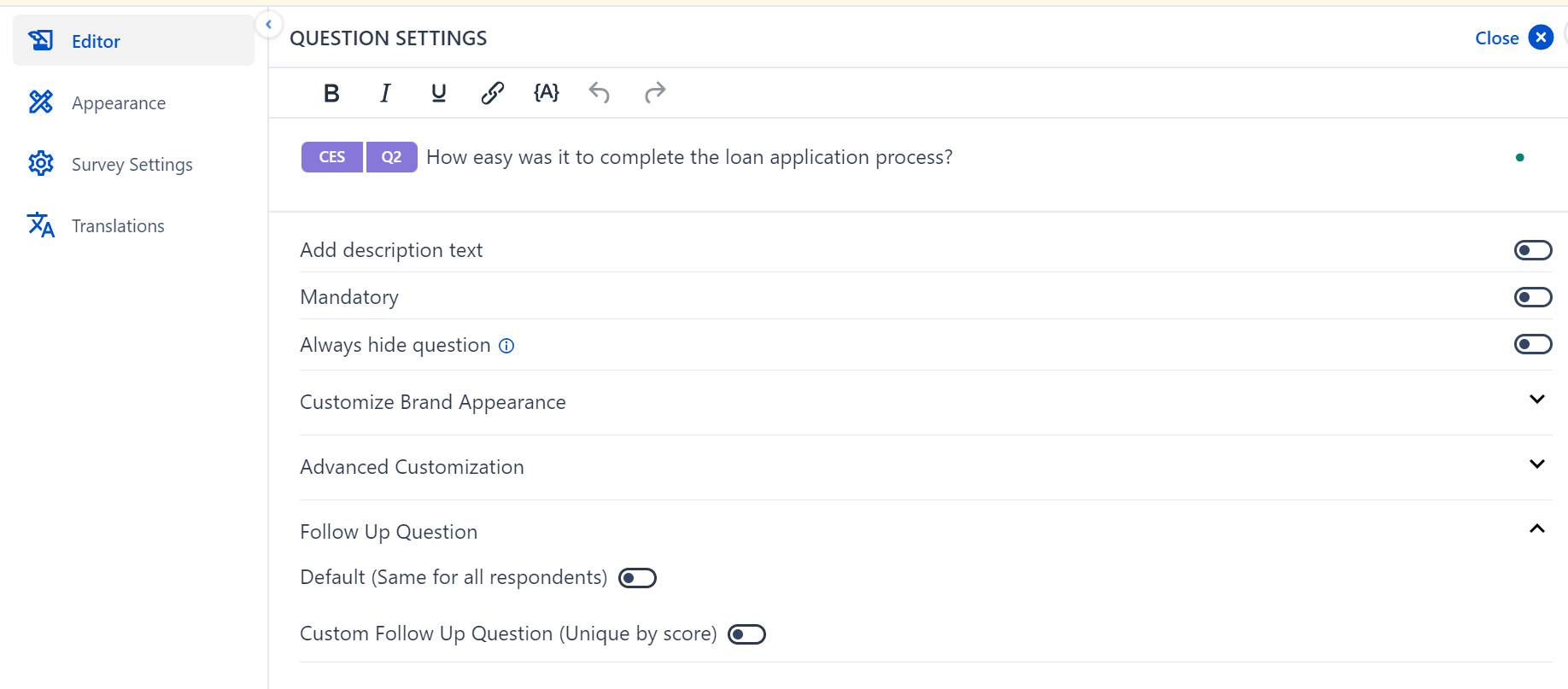
- Multi-channel platforms: SurveySensum lets you share your surveys over multiple channels to reach more audiences and facilitate better response rates. You can share the surveys over emails, WhatsApp, social media, CRM software, etc., or embed the URL to a website.
- Third-party app integration: This CES tool allows you to integrate the CES surveys with a number of third-party applications. This includes popular platforms like Hubspot, Slack, and automation tools like Zapier, allowing you to seamlessly transfer data and automate tasks.
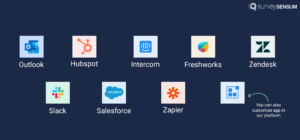
- Text analytics: SurveySensum lets you analyze the responses using text analysis software to understand the emotions and trends behind each response. It automatically extracts quantitative data from unprocessed, qualitative information to discover patterns and trends within the text.
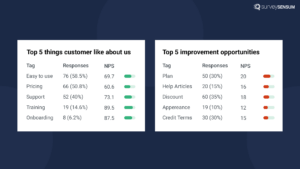
- One-on-One CX Consultation for CES Implementation: The tool also provides a dedicated CES expert who will help you set up, implement, and operate the tool to help you streamline your feedback process and achieve your business goals.
Pros:
- Exceptional support team
- Ability to run multiple feedback management programs at a time
- Create WhatsApp surveys
- Affordable
Cons:
- Need a few more integrations to support
Pricing: Starts at $299/ month if billed annually
Launch Your First CES Survey!
#2 Qualtrics
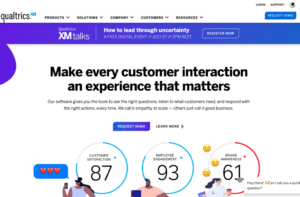
If you are looking for a reliable Customer Effort Score tool, Qualtrics is your right choice. It offers 100+ survey question types and 50+ templates. It has one of the best analytics among its competitors.
Best features:
- Online and offline surveys
- An best AI tools to improve survey response rates
- 30+ graph types and visual data representations are available
Pros:
- Provides advanced features to create and launch surveys
- Can easily integrate with existing software
Cons:
- Not easy to learn, especially for first-time users
- Too many features are often creating chaos
Pricing: Connect with the customer support team for a quote.
#3 Nicereply
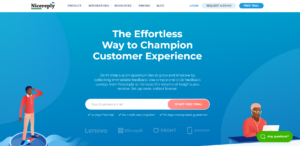
Nicereply is a great CES tool that lets you create and share surveys quickly across all customer touchpoints. It has mechanisms to track and monitor feedback, insights, and trends easily and identify dissatisfied customers easily using filters, tags, and comparison reports.
Best Features:
- Complaint monitoring & negative feedback management
- Customer engagement traceability
- Automated workflows & push notifications
Pros:
- Intuitive dashboard and reporting features
- Easy to customize and use tools
Cons:
- Functionality limitations and flexibility issues
- You need to restart the survey from scratch if some error occurs in between setups.
Pricing: Their starter plan is $59 per 3 users per month, and they offer a 14-day trial.
#4 SurveyMonkey

Another interesting Customer Effort Score tool is SurveyMonkey. It is well-known for its mobile-friendly surveys and pre-built templates. You can customize follow-up questions easily and use filters, tags, and other elements to group your surveys to create insightful reports quickly.
Best Features:
- Automatic weblinks & response validations
- 200+ pre-built survey templates
- Real-time responses, summaries, reports, and snapshots
Pros:
- Anonymous survey submission
- Unique reporting tools and custom dashboards
Cons:
- Boring and outdated theme and survey structures
- Limited branding and customization elements
Pricing:
SurveyMonkey pricing starts at $20/user/month.
#5 SurveySparrow
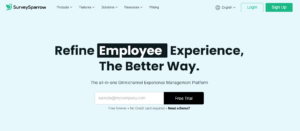
SurveySparrow tool allows you to collect both quantitative and qualitative responses from various touchpoints without hassles. The conversational UI of SurveySparrow also offers a great experience to customers.
Best Features:
- Conversational and compelling user interface
- Conditional logic, 1500+ integrations, skip logic, etc.
- Multiple User accounts under one account
Pros:
- Flexible and powerful mobile version
- Easy-to-use survey forms and built-in templates
Cons:
- Lacks email marketing features
- Too much developer dependency for bulk actions
Pricing:
Surveysparrow pricing starts at $19/month
#6 InMoment
InMoment was earlier called Wootric. It is a perfect CES tool if you are looking forward to running micro surveys or collecting advanced CES insights. It automates data analysis processes and can collaborate with NPS, CES, and CSAT surveys without problems. InMoment also provides custom filters, real-time alerts, push notifications, etc.
Best Features:
- Multilingual surveys and multi-channel platform
- Text & advanced analytics and predictive analysis
- CS strategy & design to initiate surveys based on event
Pros:
- Best customer support among its competitors
- Easy to create surveys and understand what is wrong with the help of intelligent analytics
Cons:
- No flexibility in customizing surveys and questions
- Lacks effective closed-loop evaluations and comparisons
Pricing: Contact the team for pricing
→ Looking for alternatives to InMoment that align with your business needs? Explore the top 9 InMoment alternatives and competitors to find the perfect fit for your customer experience strategy.
#7 Jotform
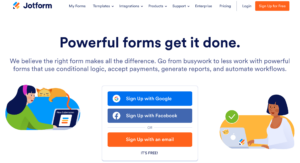
Jotform is a powerful CES tool to create engaging and visually appealing CES surveys. It enables you to gather feedback easily and integrate it with other software. The tool has several features that allow you to create effective workflows quickly.
Best Features:
- Conditional logic, skip logic, and branching
- Quick data export and import feature
- Customizable tools and templates
Pros:
- Easy to set up, use, and customize
- Several integrations, out-of-the-box widgets, and features
Cons:
- Considered more expensive than its counterparts
- Jotform is often considered spam, and mail ends up in the spam folder
Pricing: They offer a free version with 100 monthly submissions. Their paid plans start at $34/month if billed annually.
#8 Typeform
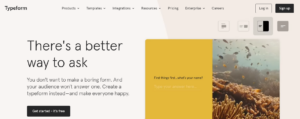
Typeform is a simple and hassle-free Customer Effort Score tool that lets you create customized surveys and questions without hassles. It is considered to be the gold standard of no-code solutions where you can personalize workflows and custom surveys quickly.
Best Features:
- Mobile-optimized surveys
- Branding customization and survey customization
- Quick data capture, transfer, extraction, exporting & importing
Pros:
- Very crisp, clear, and beautifully designed surveys
- Responding to the surveys is often fun, intuitive, and engaging
Cons:
- The interface is laggy and can’t handle complex forms
- It is expensive, and many features are way beyond affordable plans
Pricing: The basic plan starts at $25/ month.
#9 Retently

Retently is one of the best Customer Effort Score tools in 2024 that allows businesses to conduct and send short surveys quickly. It facilitates a business to segregate audiences, schedule surveys automatically, and create surveys in multiple languages hassle-free.
Best Features:
- Closed-loop management and instant analytics
- Audience segmentation and automatic survey scheduling
- Custom workflows and survey template customization
Pros:
- Great customer experience and service assistance
- Easy to set up, use, and import data
Cons:
- The basic subscription model has too many limitations
- In-app surveys miss several functionalities
Pricing: For B2B businesses their pricing plan starts from $299/month (billed annually).
Gather Customer Feedback the Right Way!
#10 Qualaroo
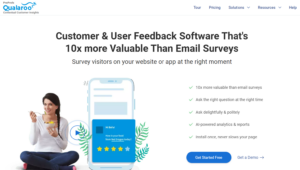
Qualaroo CES tool is designed to collect CES feedback from websites, embedded links, product pages, pop-up windows, etc. It uses Qualaroo-Nudges to transact with customers and capture responses quickly. Real-time updates, sentiment analysis, text analysis, etc, are some of its intuitive features.
Best Features:
- Offers multilingual support and multi-channel surveys
- Prototype testing, skip logic, and pre-built templates
- Design customizations and responsiveness
Pros:
- Great for targeting and white-labeling
- Pop-up tools (Nudges) for perfect A/B testing
Cons:
- Limited grouping and reporting functionality
- Cannot clone desktop nudges to mobile
Pricing: The essential package (contextual + email surveys) starts at $79/month if billed annually.
#11 – QuestionPro
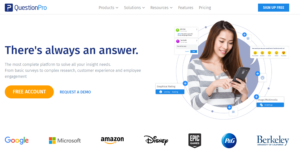
This online survey tool helps you collect data and perform qualitative and quantitative analysis. QuestionPro provides quick and easy surveys with intuitive UI and 300+ survey templates. In addition, it offers real-time reporting and a custom dashboard, making it easier to understand the survey performance.
Best Features:
- Create surveys optimized for mobile devices and share them through different platforms. These platforms include email, integrated pop-ups, SMS, QR code, and social media channels.
- Compare data across different segments or groups of respondents.
- Customize survey paths based on respondents’ answers for a more personalized experience.
Pros:
- It is simple and easy to use.
- All data is collected and stored securely.
- Multi-language support.
Cons:
- Limited customization of survey designs.
- Higher learning curve
- Expensive pricing
Pricing:
It offers a free version with limited features, and its paid plans start from $99/month for 1 user.
Final Verdict on the Top 11 CES Tools
Now as you have learned about the top 11 Customer Effort Score tools in 2024 along with their pros, cons, and important features, it is time to finalize the one that suits your requirements and budget.
The ideal way is to run the trial versions and evaluate their effectiveness, compare the prices and features of all platforms, and come to a conclusion.
Now that you know where to start and what to do, keep in mind that you need to pick the right CES tool to enjoy the benefits to their fullest. Give each one of the CES tools in the list a try and see personally what works best for you.
If you are still unsure about choosing the right software for your requirements, please feel free to reach us.
Frequently Asked Questions (FAQs) on CES Tools
In CX, CES stands for Customer Effort Score. It measures how easy it was for a customer to interact with a company, whether it’s getting a question answered, resolving a problem, or completing a transaction.
CES software helps companies create, send, and analyze Customer Effort Score surveys. It typically includes features like easy survey creation, integration with customer support and CRM tools, real-time reporting and dashboards, and automated alerts for low scores.
In the customer experience world, CES is known for measuring customer loyalty, identifying pain points, and improving overall customer experience.
The CES survey stands for Customer Effort Score survey.
It typically asks a simple question like: “How easy was it to resolve your issue with us?”






